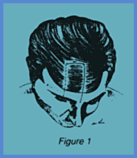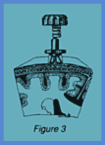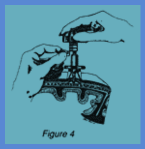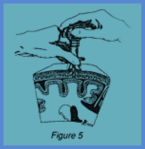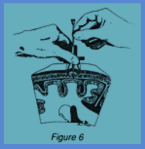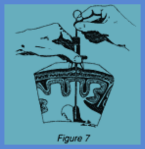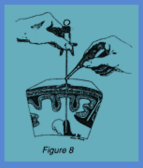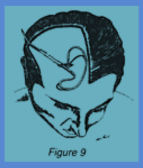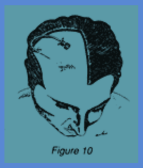INSTRUCTIONS FOR THE GHAJAR GUIDE CRANIAL DRILL & SLOTTED GUIDE SET
The Ghajar Guide® Cranial Drill is a disposable stereotactic drill system for ventriculostomy composed of a palm grip drill and guide base for cranial drilling at a right angle. The system is composed of the following:
- palm grip drill
- 4 spacer clips
- guide base
- ventricular catheter insert
This illustrated manual is for the surgeon performing cerebral ventriculostomy using The GHAJAR GUIDE® System.
Ventriculostomy is frequently an emergency procedure required for ICP monitoring and ventricular drainage. Even minor deviations in the trajectory of a twist drill hole from a perpendicular to the cranium can markedly alter the ability of the surgeon to cannulate the anterior ventricle.
The devices and procedures illustrated herein give the surgeon the capability for reproducible and accurate ventriculostomy. The surgeon may wish to alter procedural details in accordance with his or her own clinical experience and medical judgement.
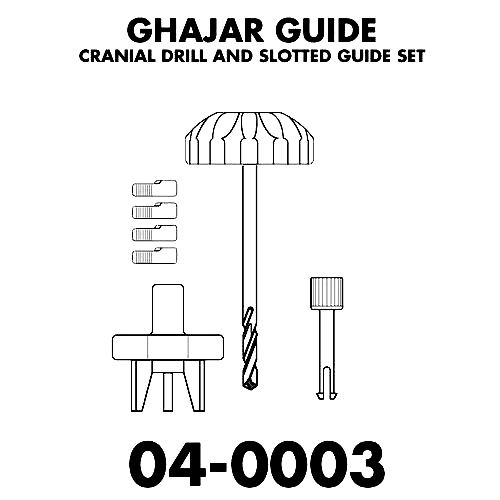
1. The twist drill hole should be made in the mid-pupillary line, slightly anterior to the coronal suture, in adults this generally measures approximately 10 cm above the nasion and 3 cm lateral to the midline. (Figure 1)
2. The scalp should be shaved on the appropriate side, depending on the presence of scalp injuries, cerebral dominance and intracranial abnormalities which should be considered by the surgeon prior to performing this procedure. A small incision (1-2 cm) is made through the scalp to the cranium. (Figure 2)
3. The guide base is seated on the scalp over the incision and the drill is inserted through the base. The tripod base must be held with all three legs firmly against the scalp. This ensures a perpendicular trajectory for the drill and subsequent perpendicular passage of the ventricular catheter. (Figure 3)
4. Approximately 1 cm of drill is exposed below the guide platform with all C-clips attached to the drill bit. Each C-clip is easily removed during drilling by pinching the ends and snapping it off the drill shaft, providing an additional 6 mm of drill exposure. (Figure 4)
5. Drill through the outer and inner tables of the skull until the dura is reached but NOT penetrated. Cotton tipped applicators may be used to remove debris in the twist drill hole. (Figure 5)
6. Carefully perforate the dura with a needle. (Figure 6)
7. Position the catheter insert into the guide base. The insert should lock into the base prior to ventriculostomy. Keeping firm, even pressure of the guide base on the scalp, manually advance a ventricular catheter into the ventricle. Normally the intracerebral length is 5 cm in adults. The catheter depth at the scalp surface is approximately 8 cm. depending upon the variability in skull and scalp thickness. (Figure 7)
8. Grasp the catheter through the legs of the guide base and lift the guide and stylet off in one motion. Test for cerebrospinal fluid manometrics. (Figure 8)
9. Using a trocar, tunnel subcutaneously away from the site of catheter insertion. Attach the catheter to one end, then pull the trocar through. (Figure 9)
10. Attach a luer hub lock to the end of the catheter after removing the trocar. Suture the incision site and secure the luer hub to the scalp with additional sutures. Apply dressing to scalp incision and connect luer hub to a drainage bag and ICP monitoring equipment. (Figure 10)
Indications
Use of THE GHAJAR GUIDE(9 Cranial Drill is indicated when cerebral ventriculostomy is required for intracranial pressure (ICP) monitoring or cerebrospinal fluid drainage procedures. In addition, this drill is indicated for drainage of chronic subdural hematomas with concurrent use of a subdural drainage system.
Contraindications
Use of THE GHAJAR GUIDE® Cranial Drill is contraindicated in children under one year of age. Ventriculostomy is contraindicated in patients with a coagulopathy.
This drill is not designed, sold, or intended for use except as indicated.
Complications
Bleeding may occur at the site of the twist drill hole, originating from the scalp, bone, dural, or cerebral areas. Due to the possibility of cerebral or extracerebral hemorrhage or any other complication of this procedure, the decision for twist drill hole placement is the sole responsibility of the attending surgeon .
Precautions
Aseptic technique must be used in preparing the surgical area during drilling, ventriculostomy, and dressing.
The catheter insert supplied is to be used with a catheter of diameter 3.2mm (French 10) only.
Sterility
THE GHAJAR GUIDE® Cranial Drill is for SINGLE USE ONLY, DO NOT RESTERILIZE. Neurodynamics, Inc. will not be responsible for any product that is resterilized, nor will we accept for credit or exchange any product that has been opened but not used. As long as the primary package is not opened or damaged, THE GHAJAR GUIDE® Cranial Drill is sterile.
Warnings
THE GHAJAR GUIDE® Cranial Drill is for single use only, do not resterilize. Responsibility will not be accepted for any product that is resterilized, nor will we accept for credit or exchange any product that has been opened but not used.
To produce an accurate twist drill hole and subsequent ventriculostomy, THE GHAJAR GUIDE® tripod base must be held with all three legs firmly against the scalp or skull surface. This ensures a perpendicular trajectory for the drill and ventricular catheter.
The length of drill exposed during drilling is determined by the surgeon by removing C-clips on the shaft of the drill bit (the length may be varied in steps from approximately 1 cm to 3.5cm).
Extreme care must be used to avoid damage of the dura and underlying cerebrum.
Caution
Federal Law (U.S.A. ) restricts the sale of this device to a physician or by his order.
Warranty
Neurodynamics, Inc., warrants that this medical device is free from defects in both materials and workmanship. THE ABOVE WARRANTIES ARE IN LIEU OF ALL OTHER WARRANTIES, EITHER EXPRESS OR IMPLIED, INCLUDING ANY WARRANTY OF MERCHANTABILITY OR FITNESS FOR A PARTICULAR PURPOSE. Suitability for use of the medical device for any surgical procedure shall be determined by the user. Neurodynamics shall not be liable for incidental or consequential damages of any kind.

